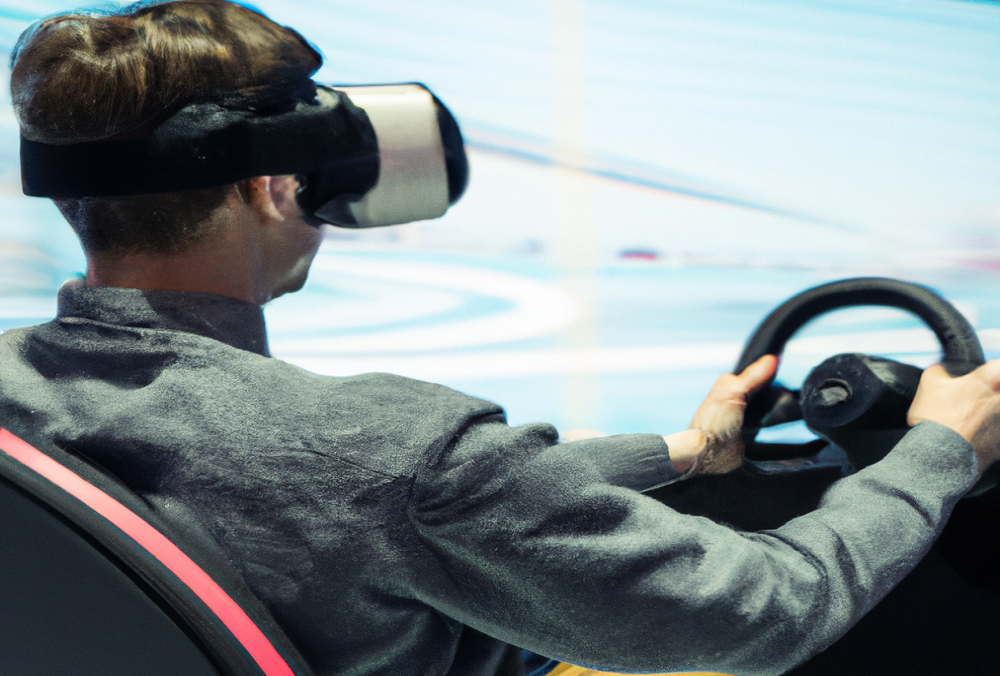Virtual Reality Gaming: A New Era in Interactive Entertainment
Virtual Reality (VR) has been a buzzword for the gaming industry for quite some time. However, it has only been in the last few years that it has become a practical and affordable technology for the masses. The rise of virtual reality is one of the most significant trends in gaming today. It is poised to revolutionize the way we play, interact, and consume games. In this article, we will explore the next frontier in gaming and how the rise of virtual reality is transforming the gaming industry.
What is Virtual Reality (VR)?
Virtual reality is an immersive technology that creates a computer-generated simulation of a three-dimensional environment. It is achieved by using a head-mounted display (HMD) that tracks the movement of the user's head, allowing them to explore the virtual world in real-time. The user can interact with the virtual world using specialized controllers, gestures, and voice commands.
The Rise of Virtual Reality in Gaming
The gaming industry has always been at the forefront of technological innovation. It has constantly pushed the boundaries of what is possible in terms of graphics, gameplay, and interactivity. Virtual reality is the next logical step in the evolution of gaming. It promises to take gaming to a whole new level of immersion and interactivity.
The first wave of virtual reality games was released in the mid-1990s. However, the technology was expensive and limited to a small number of enthusiasts. It wasn't until the release of the Oculus Rift in 2016 that virtual reality became accessible to the masses. The Oculus Rift was the first affordable, high-quality VR headset that offered a truly immersive experience.
Since then, the number of VR games and experiences has grown rapidly. There are now hundreds of VR games available across all platforms, including PlayStation VR, HTC Vive, and Oculus Quest. The rise of virtual reality has also led to the development of new genres of games that are specifically designed for VR, such as VR puzzle games and VR escape rooms.
Advantages of Virtual Reality in Gaming
- Realistic Gaming Experience
The most significant advantage of VR in gaming is the ability to create a more realistic gaming experience. With the help of high-end VR headsets, gamers can enter a completely different world and feel like they are actually inside the game. This level of immersion has never been possible before, making VR an ideal medium for gamers who want to experience a game as realistically as possible.
For example, racing games become much more exciting and engaging when played in VR. Instead of watching a screen, gamers can feel like they are actually driving the car, with the ability to look around and see the surroundings. Similarly, first-person shooter games become much more immersive when played in VR, allowing players to feel like they are really inside the game, dodging bullets and firing weapons.
- Interactive Gaming Experience
Another advantage of VR in gaming is its ability to create a more interactive gaming experience. With the help of motion controllers and haptic feedback, gamers can physically interact with the virtual environment, adding a new layer of immersion and engagement to the gameplay. For example, gamers can use motion controllers to shoot arrows, throw objects, or swing a sword, making the game feel much more realistic and interactive.
In addition, haptic feedback allows gamers to feel the impact of their actions in the game, making the experience even more immersive. For example, when playing a shooting game, haptic feedback can simulate the recoil of the gun, making the player feel like they are actually firing a weapon.
- Enhanced Social Gaming Experience
VR in gaming also offers an enhanced social gaming experience. With the help of multiplayer VR games, gamers can connect with other players from around the world and interact with them in a virtual environment. This not only adds a new dimension to the gameplay but also creates a sense of community and socialization, allowing gamers to make new friends and share their gaming experiences with others.
VR gaming also provides a unique opportunity for remote co-op gameplay. With the help of VR, gamers can feel like they are playing in the same room as their friends, even if they are miles apart. This creates a more collaborative and engaging gaming experience, allowing gamers to work together to complete challenges and objectives.
- New Genres of Gaming
The rise of VR in gaming has given rise to a whole new genres of gaming, offering players a unique and engaging gaming experience. For example, escape room games have become popular in VR, providing players with a virtual environment where they must solve puzzles and complete challenges to escape. Similarly, simulation games have become more engaging in VR, allowing players to experience different jobs, hobbies, and activities in a more realistic and immersive way.
Moreover, VR in gaming has also given rise to new types of games, such as rhythm games, where players must match the beat of the music by physically moving their body. This type of gameplay would not be possible without VR, making it a truly unique and innovative gaming experience.
Challenges of Virtual Reality in Gaming
- Hardware Limitations:
One of the most significant challenges that virtual reality in gaming faces is hardware limitations. VR requires specialized hardware to function correctly, and the hardware can be expensive to develop and purchase. VR headsets, for example, require high-resolution displays with low latency, which can increase the cost of the product. Moreover, VR games require powerful hardware to function efficiently, which can be costly for an average consumer.
In addition to hardware costs, another challenge faced by virtual reality gaming is the lack of standardization in VR hardware and software. Different companies have developed their own VR hardware and software, which can lead to compatibility issues between different devices. This lack of standardization can also make it difficult for game developers to create games that work on all VR platforms.
- Limited Content:
Another challenge facing virtual reality in gaming is the limited content available. Although the number of VR games has been increasing, it still lags behind traditional gaming platforms in terms of the amount and variety of content available. This is partly due to the high cost of developing VR games and the relatively small audience for these games.
Many game developers are still trying to figure out how to create engaging and immersive experiences in VR. VR requires a different approach to game design than traditional games, which can be a challenge for developers who are used to designing games for 2D screens.
- User Comfort:
User comfort is one of the significant challenges that virtual reality gaming faces. VR can cause motion sickness, nausea, and disorientation in some users, which can limit their ability to play VR games for extended periods. These issues are caused by the disconnect between the movement that the user sees in the game and the movement that their body feels. This can lead to a feeling of motion sickness, similar to that experienced on a boat or in a car.
To address these issues, game developers are working to create games that are more comfortable for users to play. This includes reducing the amount of movement in the game, adding comfort settings that allow users to adjust the game to their comfort level, and designing games that are less intense.
- Social Isolation:
Virtual reality in gaming can be an isolating experience for some players. Although the technology allows players to immerse themselves in a virtual world, it can also cut them off from the real world. This can be especially problematic for individuals who use gaming as a social outlet. With VR, players can feel cut off from their friends and family, leading to feelings of loneliness and social isolation.
Game developers are aware of this challenge and are working to address it by creating VR games that allow players to interact with other players in the virtual world. Additionally, some VR games are being designed to encourage socialization, such as games that require players to work together to solve puzzles.
Bottom-Line
The rise of virtual reality is the next frontier in gaming. It promises to transform the way we play, interact, and consume games. Virtual reality provides a level of immersion and interactivity that is unmatched by any other technology, and it has the potential to create new genres of games and experiences. Despite the challenges that virtual reality currently faces, the future of VR gaming is bright, and we can expect to see continued growth and innovation in the years to come. As more people experience VR gaming, we can expect to see a new era of gaming that is more immersive, engaging, and social than ever before.






